Temperature-Program Assisted Synthesis of Novel Z-Scheme CuBi2O4/β-Bi2O3 Composite with Enhanced Visible Light Photocatalytic Performance
Abstract
:1. Introduction
2. Materials and Methods
2.1. Materials
2.2. Synthesis of CuBi2O4/β-Bi2O3
2.3. Characterization
2.4. Photocatalytic Performance Experiments
2.5. Analysis of Reactive Species
3. Results and Discussion
4. Conclusions
Author Contributions
Funding
Acknowledgments
Conflicts of Interest
References
- Song, S.; Su, Y.; Adeleye, A.S.; Zhang, Y.; Zhou, X. Optimal design and characterization of sulfide-modified nanoscale zerovalent iron for diclofenac removal. Appl. Catal. B Environ. 2017, 201, 211–220. [Google Scholar] [CrossRef]
- Thiruppathi, M.; Kumar, P.S.; Devendran, P.; Ramalingan, C.; Swaminathan, M.; Nagarajan, E.R. Ce@TiO2 nanocomposites: An efficient, stable and affordable photocatalyst for the photodegradation of diclofenac sodium. J. Alloys Compd. 2017, 735, 728–734. [Google Scholar] [CrossRef]
- Espino-Estévez, M.R.; Fernández-Rodríguez, C.; González-Díaz, O.M.; Araña, J.; Espinós, J.P.; Ortega-Méndez, J.A.; Doña-Rodríguez, J.M. Effect of TiO2-Pd and TiO2-Ag on the photocatalytic oxidation of diclofenac, isoproturon and phenol. Chem. Eng. J. 2016, 298, 82–95. [Google Scholar] [CrossRef]
- Chen, X.J.; Li, N.; Xu, S.; Wang, H.L.; Cai, Y.M. Study on the visible-light photocatalytic performance and degradation mechanism of diclofenac sodium under the system of hetero-structural CuBi2O4/Ag3PO4 with H2O2. Materials 2018, 11, 511. [Google Scholar] [CrossRef] [PubMed]
- Liao, C.H.; Huang, C.W.; Wu, J.C.S. Hydrogen production from semiconductor-based photocatalysis via water splitting. Catalysts 2012, 2, 490–516. [Google Scholar] [CrossRef]
- Natarajan, T.S.; Thampi, K.R.; Tayade, R.J. Visible light driven redox-mediator-free dual semiconductor photocatalytic systems for pollutant degradation and the ambiguity in applying Z-scheme concept. Appl. Catal. B Environ. 2018, 227, 296–311. [Google Scholar] [CrossRef]
- Wang, L.; Cai, M.; Sun, W.; He, L.; Zhang, X. Promoting charge separation in semiconductor nanocrystal superstructures for enhanced photocatalytic activity. Adv. Mater. Interfaces 2018, 1701694. [Google Scholar] [CrossRef]
- Zhou, P.; Yu, J.; Jaroniec, M. All-solid-state Z-scheme photocatalytic systems. Adv. Mater. 2014, 26, 4920–4935. [Google Scholar] [CrossRef] [PubMed]
- Bianchi, C.L.; Pirola, C.; Galli, F.; Stucchi, M.; Morandi, S.; Cerrato, G.; Capucci, V. Nano and micro-TiO2 for the photodegradation of ethanol: Experimental data and kinetic modelling. RSC Adv. 2015, 5, 53419–53425. [Google Scholar] [CrossRef]
- Ochiai, T.; Fujishima, A. Photoelectrochemical properties of TiO2 photocatalyst and its applications for environmental purification. J. Photochem. Photobiol. C Photochem. Rev. 2012, 13, 247–262. [Google Scholar] [CrossRef]
- Kumar, S.G.; Devi, L.G. Review on modified TiO2 photocatalysis under UV/visible light: Selected results and related mechanisms on interfacial charge carrier transfer dynamics. J. Phys. Chem. A 2011, 115, 13211–13241. [Google Scholar] [CrossRef] [PubMed]
- Pelaez, M.; Nolan, N.T.; Pillai, S.C.; Seery, M.K.; Falaras, P.; Kontos, A.G.; Dunlop, P.S.M.; Hamilton, J.W.J.; Byrne, J.A.; O’Shea, K. A review on the visible light active titanium dioxide photocatalysts for environmental applications. Appl. Catal. B Environ. 2012, 125, 331–349. [Google Scholar] [CrossRef] [Green Version]
- Wang, Y.; Wang, Q.; Zhan, X.; Wang, F.; Safdar, M.; He, J. Visible light driven type II heterostructures and their enhanced photocatalysis properties: A review. Nanoscale 2013, 5, 8326–8339. [Google Scholar] [CrossRef] [PubMed]
- Moniz, S.J.A.; Shevlin, S.A.; Martin, D.J.; Guo, Z.X.; Tang, J. Visible-light driven heterojunction photocatalysts for water splitting-a critical review. Energy Environ. Sci. 2015, 8, 731–759. [Google Scholar] [CrossRef]
- Dong, S.; Feng, J.; Fan, M.; Pi, Y.; Hu, L.; Han, X.; Liu, M.; Sun, J.; Sun, J. Recent developments in heterogeneous photocatalytic water treatment using visible light-responsive photocatalysts: A review. RSC Adv. 2015, 5, 14610–14630. [Google Scholar] [CrossRef]
- Chen, X.J.; Dai, Y.Z.; Guo, J. Hydrothermal synthesis of well-distributed spherical CuBi2O4 with enhanced photocatalytic activity under visible light irradiation. Mater. Lett. 2015, 161, 251–254. [Google Scholar] [CrossRef]
- Guo, F.; Shi, W.; Wang, H.; Han, M.; Guan, W.; Huang, H.; Liu, Y.; Kang, Z. Study on highly enhanced photocatalytic tetracycline degradation of type II AgI/CuBi2O4 and Z-scheme AgBr/CuBi2O4 heterojunction photocatalysts. J. Hazard. Mater. 2018, 349, 111–118. [Google Scholar] [CrossRef] [PubMed]
- Oh, W.D.; Lua, S.K.; Dong, Z.; Lim, T.T. Rational design of hierarchically-structured CuBi2O4 composites by deliberate manipulation of the nucleation and growth kinetics of CuBi2O4 for environmental applications. Nanoscale 2015, 8, 2046–2054. [Google Scholar] [CrossRef] [PubMed]
- Hossain, M.K.; Samu, G.F.; Gandha, K.; Santhanagopalan, S.; Liu, J.P.; Janáky, C.; Rajeshwar, K. Solution combustion synthesis, characterization, and photocatalytic activity of CuBi2O4 and its nanocomposites with CuO and α-Bi2O3. J. Phys. Chem. C 2017, 121, 8252–8261. [Google Scholar] [CrossRef]
- Wang, Y.; Li, F.; Xue, T.; Liu, C.; Yuan, D.; Qi, F.; Xu, B. Heterogeneous activation of peroxymonosulfate by hierarchical CuBi2O4 to generate reactive oxygen species for refractory organic compounds degradation: Morphology and surface chemistry derived reaction and its mechanism. Environ. Sci. Pollut. Res. 2018, 25, 4419–4434. [Google Scholar] [CrossRef] [PubMed]
- Muñozbatista, M.J.; Kubacka, A.; Fontellescarceller, O.; Tudela, D.; Fernandezgarcia, M. Surface CuO, Bi2O3, and CeO2 species supported in TiO2-anatase: Study of interface effects in toluene photodegradation quantum efficiency. ACS Appl. Mater. Interfaces 2016, 8, 13934–13945. [Google Scholar] [CrossRef] [PubMed] [Green Version]
- Chen, Y.; Zhang, Y.; Luo, L.; Shi, Y.; Wang, S.; Li, L.; Long, Y.; Jiang, F. A novel templated synthesis of C/N-doped β-Bi2O3 nanosheets for synergistic rapid removal of 17α-ethynylestradiol by adsorption and photocatalytic degradation. Ceram. Int. 2018, 44, 2178–2185. [Google Scholar] [CrossRef]
- Gadhi, T.A.; Hernández, S.; Castellino, M.; Jagdale, P.; Husak, T.; Hernández-Gordillo, A.; Tagliaferro, A.; Russo, N. Insights on the role of β-Bi2O3/Bi5O7NO3 heterostructures synthesized by a scalable solid-state method for the sunlight-driven photocatalytic degradation of dyes. Catal. Today 2018. [Google Scholar] [CrossRef]
- Hwang, H.; Shin, J.; Lee, K.Y.; Choi, W. Facile one-pot transformation using structure-guided combustion waves of micro-nanostructured β-Bi2O3 to α-Bi2O3@C and analysis of electrochemical capacitance. Appl. Surf. Sci. 2018, 428, 422–431. [Google Scholar] [CrossRef]
- Chang, C.; Yang, H.C.; Gao, N.; Lu, S.Y. Core/shell p-BiOI/n-β-Bi2O3 heterojunction array with significantly enhanced photoelectrochemical water splitting efficiency. J. Alloys Compd. 2018, 738, 138–144. [Google Scholar] [CrossRef]
- Hong, Y.; Li, C.; Yin, B.; Li, D.; Zhang, Z.; Mao, B.; Fan, W.; Gu, W.; Shi, W. Promoting visible-light-induced photocatalytic degradation of tetracycline by an efficient and stable beta-Bi2O3@g-C3N4 core/shell nanocomposite. Chem. Eng. J. 2018, 338, 137–146. [Google Scholar] [CrossRef]
- Xiong, M.; Chen, L.; Yuan, Q.; He, J.; Luo, S.L.; Au, C.T.; Yin, S.F. Controlled synthesis of graphitic carbon nitride/beta bismuth oxide composite and its high visible-light photocatalytic activity. Carbon 2015, 86, 217–224. [Google Scholar] [CrossRef]
- Cong, Y.; Wang, J.; Jin, H.; Xiao, F.; Qi, W.; Yun, J.; Yi, Z. Enhanced photoelectrocatalytic activity of a novel Bi2O3-BiPO4 composite electrode for the Degradation of refractory pollutants under visible light irradiation. Ind. Eng. Chem. Res. 2016, 55, 1221–1228. [Google Scholar] [CrossRef]
- Bazargan, A.; Yan, Y.; Hui, C.W.; Mckay, G. A Review: Synthesis of carbon-based nano and micro materials by high temperature and high pressure. Ind. Eng. Chem. Res. 2013, 52, 12689–12702. [Google Scholar] [CrossRef]
- Berglund, S.P.; Abdi, F.F.; Bogdanoff, P.; Chemseddine, A.; Friedrich, D.; Krol, R.V.D. Comprehensive evaluation of CuBi2O4 as a photocathode material for photoelectrochemical water splitting. Chem. Mater. 2016, 28, 4231–4242. [Google Scholar] [CrossRef]
- Chang, C.; Zhu, L.; Wang, S.; Chu, X.; Yue, L. Novel mesoporous graphite carbon nitride/BiOI heterojunction for enhancing photocatalytic performance under visible-light irradiation. ACS Appl. Mater. Interfaces 2014, 6, 5083–5093. [Google Scholar] [CrossRef] [PubMed]
- Xiao, X.; Hu, R.; Liu, C.; Xing, C.; Qian, C.; Zuo, X.; Nan, J.; Wang, L. Facile large-scale synthesis of β-Bi2O3 nanospheres as a highly efficient photocatalyst for the degradation of acetaminophen under visible light irradiation. Appl. Catal. B Environ. 2013, 140–141, 433–443. [Google Scholar] [CrossRef]
- Patil, R.; Kelkar, S.; Naphade, R.; Ogale, S. Low temperature grown CuBi2O4 with flower morphology and its composite with CuO nanosheets for photoelectrochemical water splitting. J. Mater. Chem. A 2014, 2, 3661–3668. [Google Scholar] [CrossRef]
- Wang, Q.; Liu, E.; Zhang, C.; Huang, S.; Cong, Y.; Zhang, Y. Synthesis of Cs3PMo12O40/Bi2O3 composite with highly enhanced photocatalytic activity under visible-light irradiation. J. Colloid Interface Sci. 2018, 516, 304–311. [Google Scholar] [CrossRef] [PubMed]
- Li, Y.; Wang, J.; Yao, H.; Dang, L.; Li, Z. Chemical etching preparation of BiOI/Bi2O3 heterostructures with enhanced photocatalytic activities. Catal. Commun. 2011, 12, 660–664. [Google Scholar] [CrossRef]
- Li, J.; Zhong, J.; He, X.; Huang, S.; Zeng, J.; He, J.; Shi, W. Enhanced photocatalytic activity of Fe2O3 decorated Bi2O3. Appl. Surf. Sci. 2013, 284, 527–532. [Google Scholar] [CrossRef]
- Uchida, K.; Ayame, A. Dynamic XPS measurements on bismuth molybdate surfaces. Surf. Sci. 1996, 357–358, 170–175. [Google Scholar] [CrossRef]
- Diez, E.; Monnereau, O.; Tortet, L.; Vacquier, G.; Llewellin, P.; Rouquerol, F. Synthesis of bismuth (III) oxide from oxalate: A study by controlled transformation rate thermal analysis (CRTA). J. Optoelectron. Adv. Mater. 2000, 2, 552–556. [Google Scholar]
- Guo, J.; Ouyang, S.; Zhou, H.; Kako, T.; Ye, J. Ag3PO4/In(OH)3 composite photocatalysts with adjustable surface-electric property for efficient photodegradation of organic dyes under simulated solar-light irradiation. J. Phys. Chem. C 2013, 117, 17716–17724. [Google Scholar] [CrossRef]
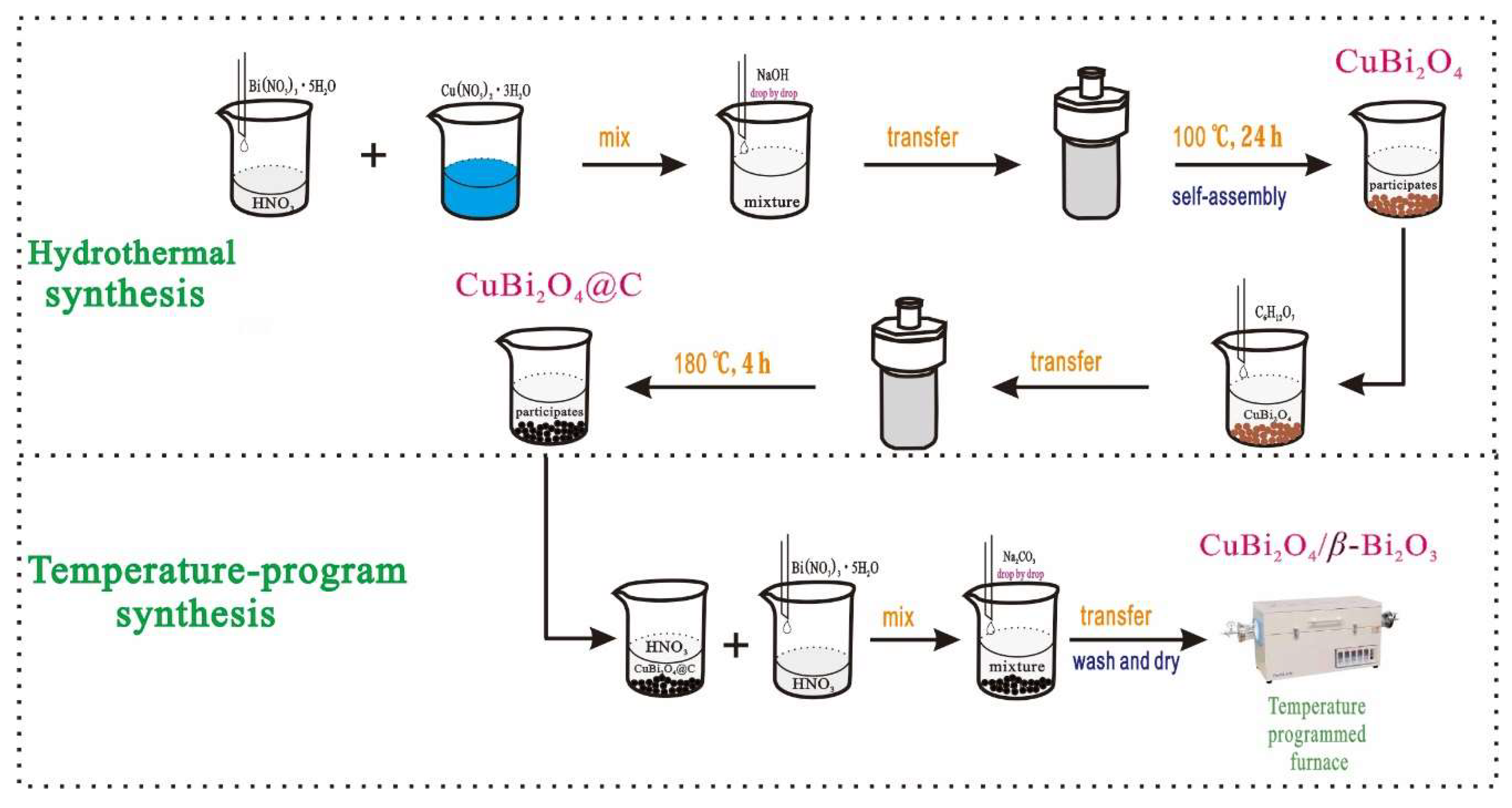
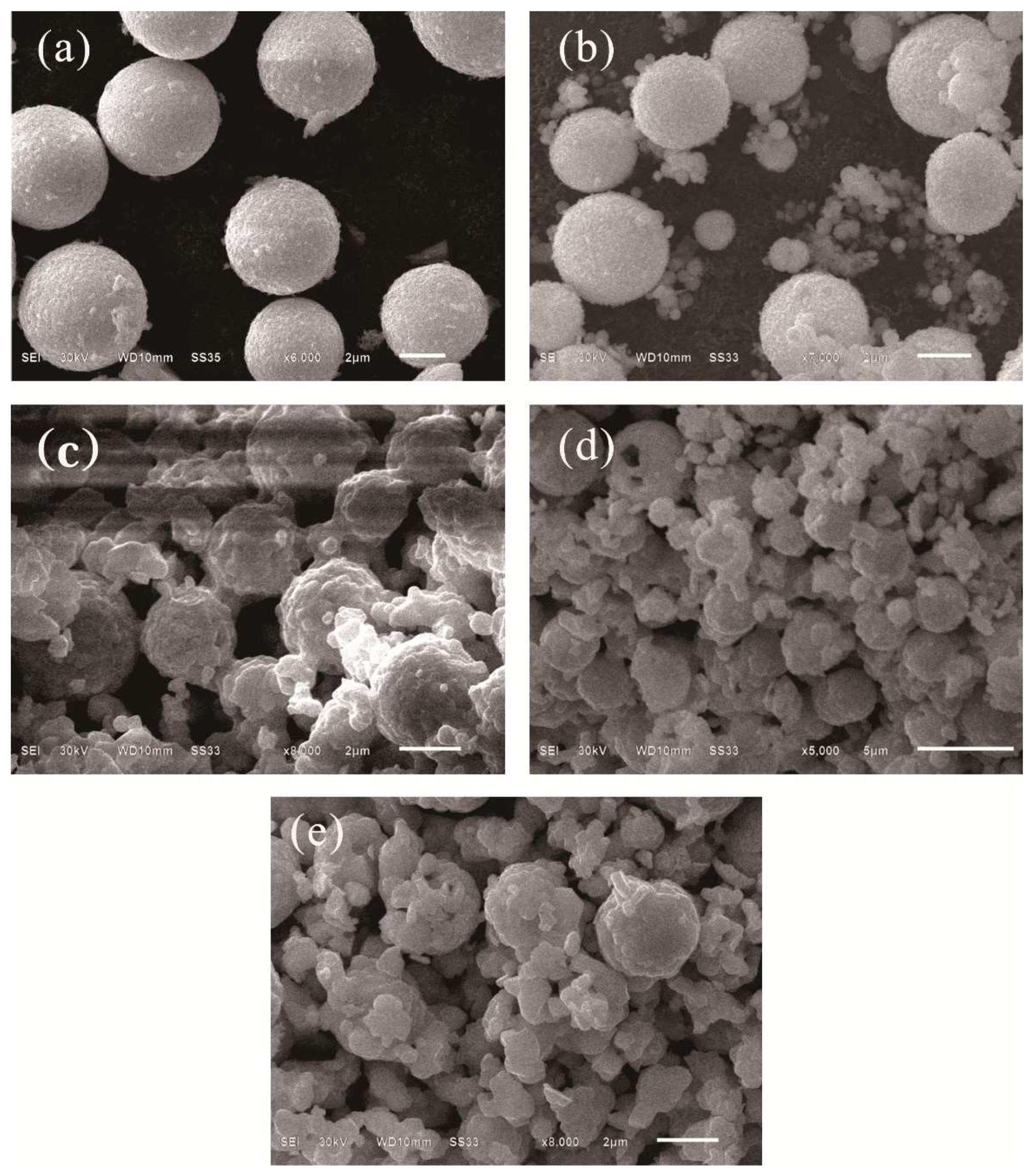


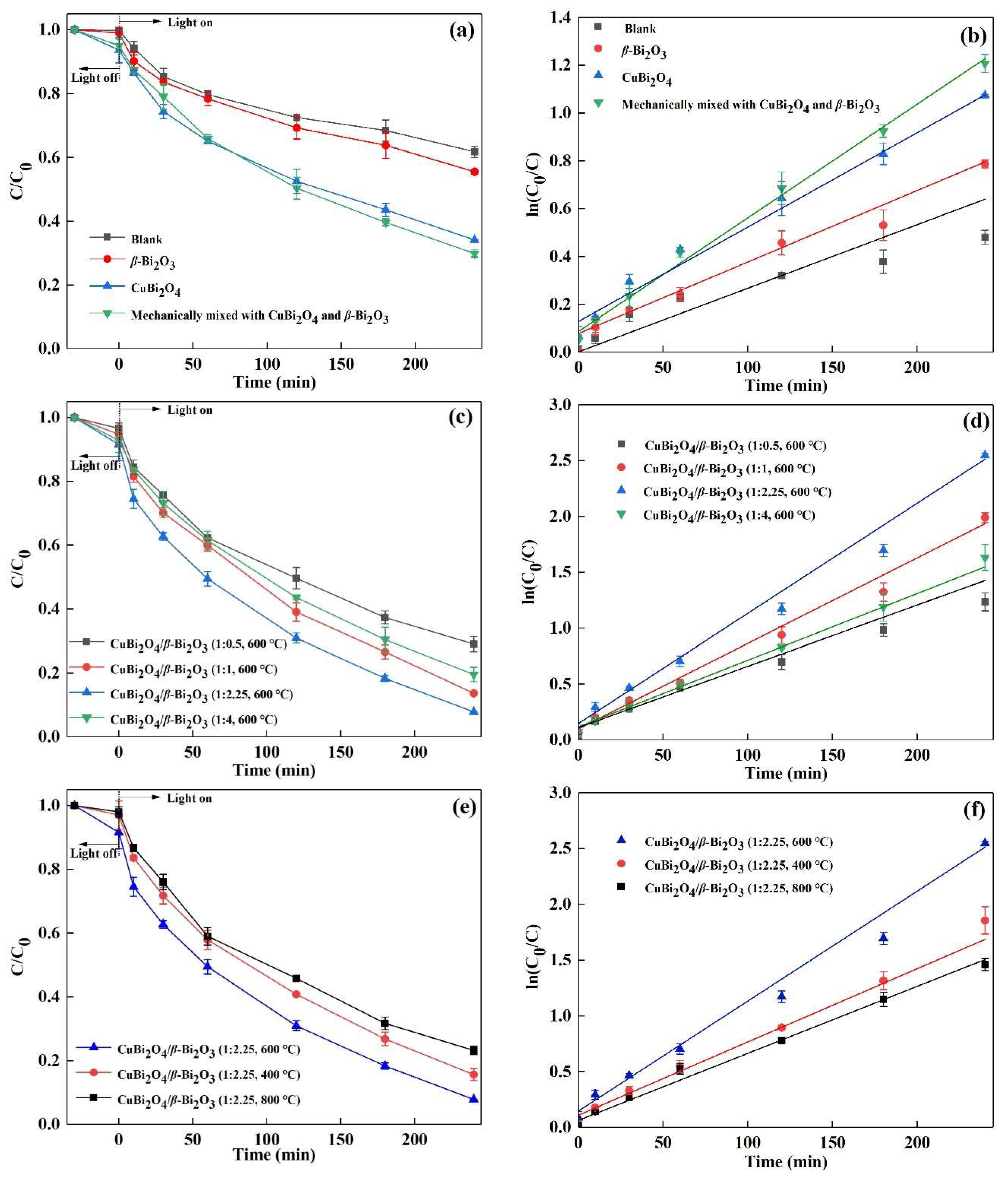
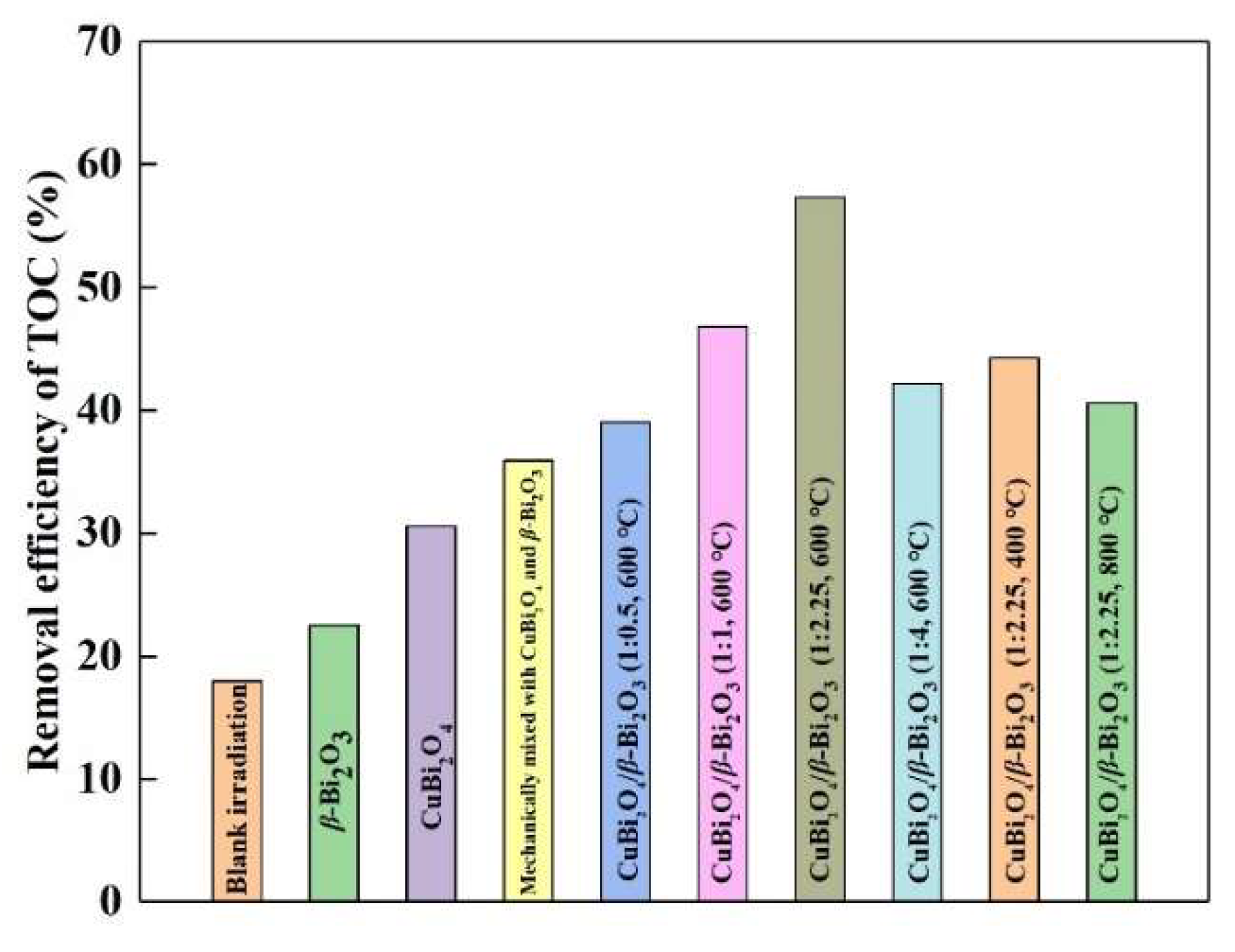
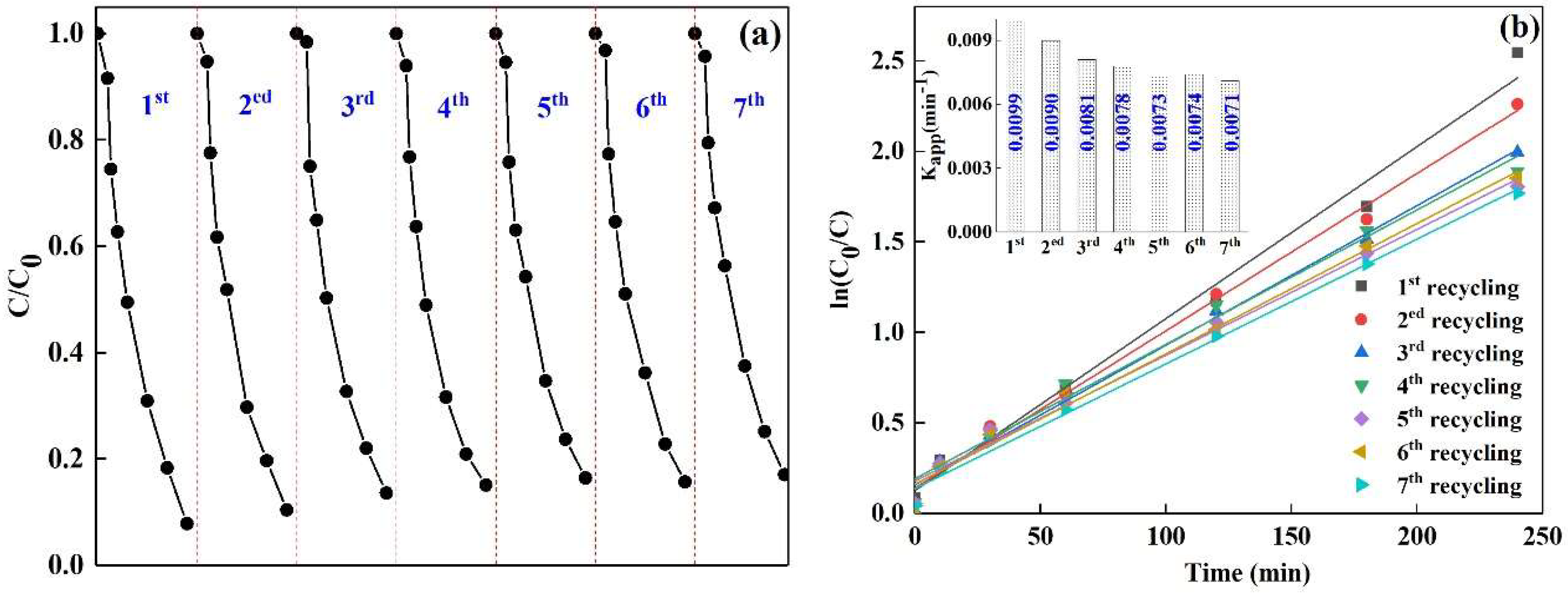
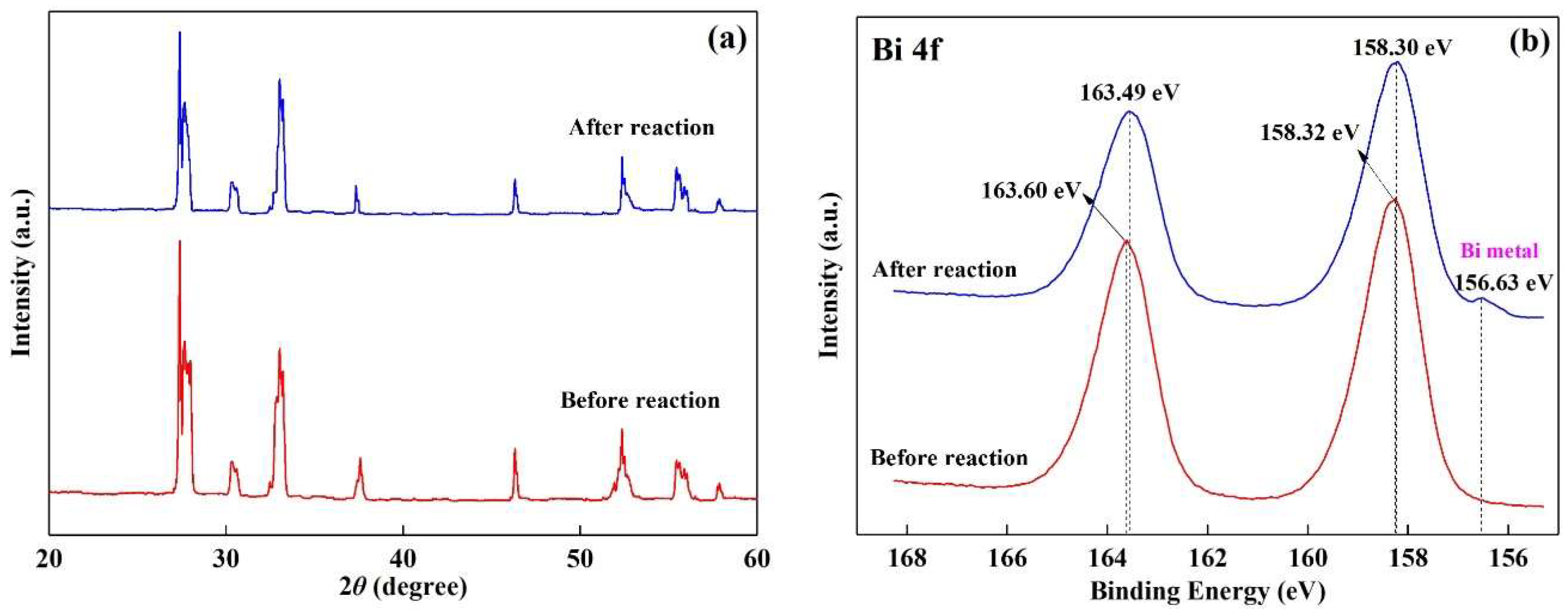
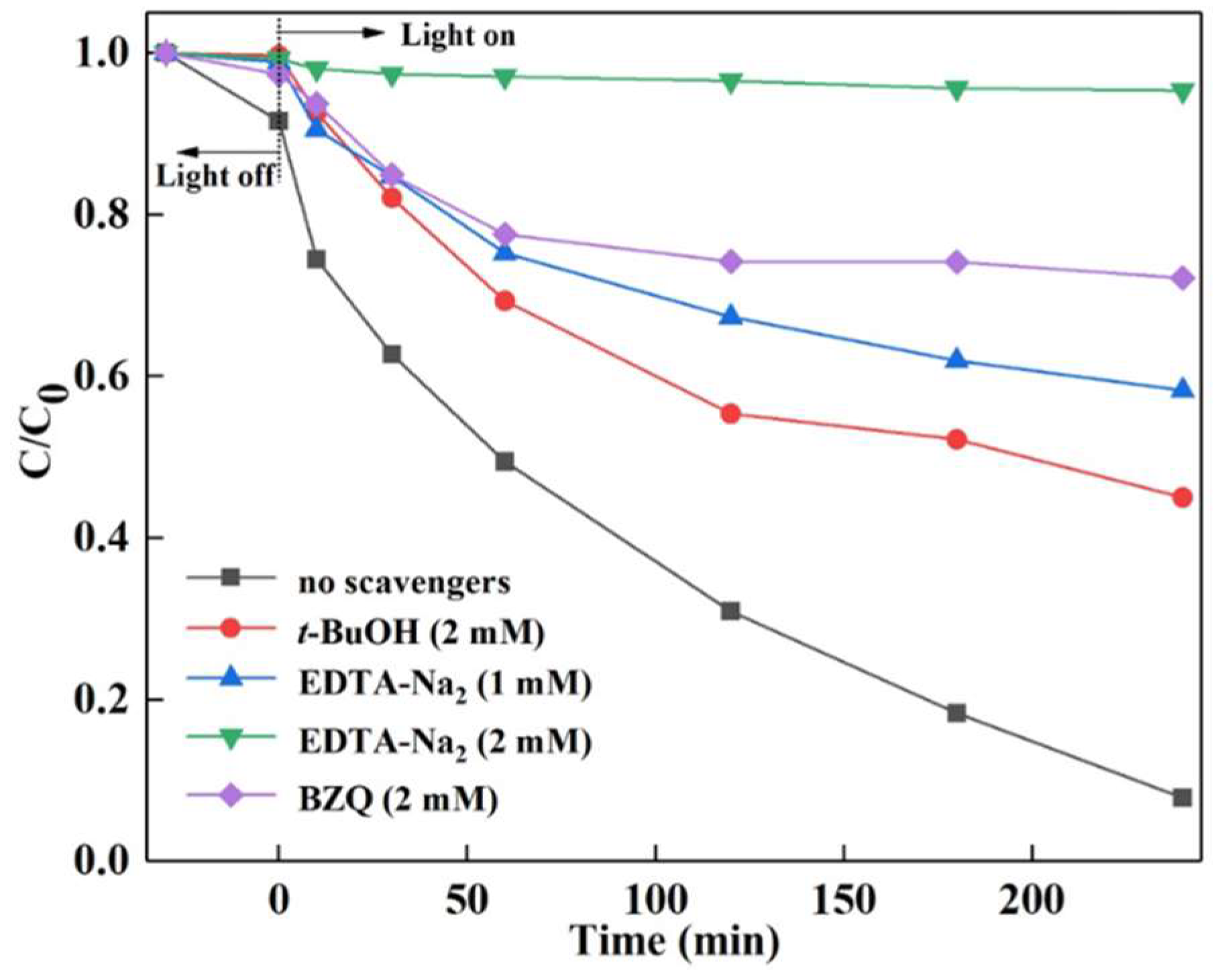
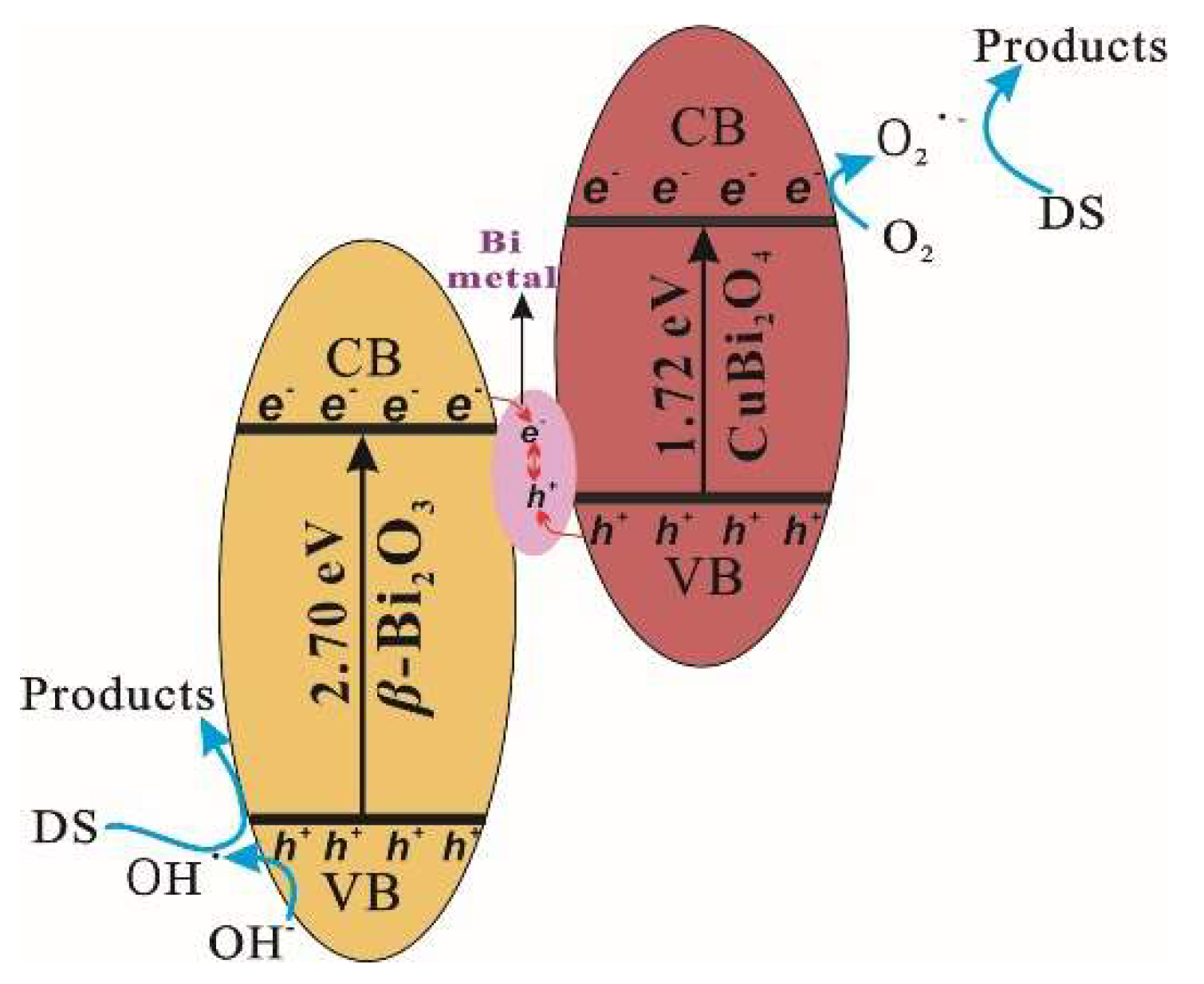
| Photocatalytic System | Kapp (min−1) | R2 |
|---|---|---|
| Blank irradiation | 0.0027 | 0.92 |
| β-Bi2O3 | 0.0030 | 0.90 |
| CuBi2O4 | 0.0040 | 0.94 |
| Mechanically mixed with CuBi2O4 and β-Bi2O3 | 00048 | 0.94 |
| CuBi2O4/β-Bi2O3 (1:0.5, 600 °C) | 0.0055 | 0.92 |
| CuBi2O4/β-Bi2O3 (1:1, 600 °C) | 0.0076 | 0.91 |
| CuBi2O4/β-Bi2O3 (1:2.25, 600 °C) | 0.0099 | 0.90 |
| CuBi2O4/β-Bi2O3 (1:4, 600 °C) | 0.0059 | 0.96 |
| CuBi2O4/β-Bi2O3 (1:2.25, 400 °C) | 0.0065 | 0.95 |
| CuBi2O4/β-Bi2O3 (1:2.25, 800 °C) | 0.0060 | 0.95 |
© 2018 by the authors. Licensee MDPI, Basel, Switzerland. This article is an open access article distributed under the terms and conditions of the Creative Commons Attribution (CC BY) license (http://creativecommons.org/licenses/by/4.0/).
Share and Cite
Chen, X.; Li, N.; Zhu, R.; Li, S.; Yu, C.; Xia, W.; Xu, S.; Chen, X. Temperature-Program Assisted Synthesis of Novel Z-Scheme CuBi2O4/β-Bi2O3 Composite with Enhanced Visible Light Photocatalytic Performance. Nanomaterials 2018, 8, 579. https://doi.org/10.3390/nano8080579
Chen X, Li N, Zhu R, Li S, Yu C, Xia W, Xu S, Chen X. Temperature-Program Assisted Synthesis of Novel Z-Scheme CuBi2O4/β-Bi2O3 Composite with Enhanced Visible Light Photocatalytic Performance. Nanomaterials. 2018; 8(8):579. https://doi.org/10.3390/nano8080579
Chicago/Turabian StyleChen, Xiaojuan, Ning Li, Runliang Zhu, Shuai Li, Chunmo Yu, Wei Xia, Song Xu, and Xin Chen. 2018. "Temperature-Program Assisted Synthesis of Novel Z-Scheme CuBi2O4/β-Bi2O3 Composite with Enhanced Visible Light Photocatalytic Performance" Nanomaterials 8, no. 8: 579. https://doi.org/10.3390/nano8080579
APA StyleChen, X., Li, N., Zhu, R., Li, S., Yu, C., Xia, W., Xu, S., & Chen, X. (2018). Temperature-Program Assisted Synthesis of Novel Z-Scheme CuBi2O4/β-Bi2O3 Composite with Enhanced Visible Light Photocatalytic Performance. Nanomaterials, 8(8), 579. https://doi.org/10.3390/nano8080579





